1856-1865
1856
 One
of the most celebrated units in the history of the U.S. Army, the 2nd
Cavalry, arrives in Texas to deal with the Plains Indian challenge. Hand-picked
by U.S. Secretary of War Jefferson Davis, the officer corps includes 16
future Civil War generals, among them Robert E. Lee, Albert Sidney Johnston,
William J. Hardee, Edmund Kirby Smith, John Bell Hood, and George Thomas.
One
of the most celebrated units in the history of the U.S. Army, the 2nd
Cavalry, arrives in Texas to deal with the Plains Indian challenge. Hand-picked
by U.S. Secretary of War Jefferson Davis, the officer corps includes 16
future Civil War generals, among them Robert E. Lee, Albert Sidney Johnston,
William J. Hardee, Edmund Kirby Smith, John Bell Hood, and George Thomas.
 Camp Cooper is established as a 2nd Cavalry post on Clear Fork
Comanche reservation; other primary posts include Fort Mason, Fort Clark,
and newly-established Camp Verde, base for the army's "camel corps."
Camp Cooper is established as a 2nd Cavalry post on Clear Fork
Comanche reservation; other primary posts include Fort Mason, Fort Clark,
and newly-established Camp Verde, base for the army's "camel corps."
Expeditions of 2nd Cavalry reach the Pecos River and the headwaters of the Brazos River.
1857
U.S. Postmaster grants Butterfield Overland Mail Company an exclusive contract for mail service between St. Louis, Mo., and San Francisco, Calif., via El Paso; contract for service from San Antonio to San Diego, Calif., via El Paso is awarded to James Birch.
Army establishes camps Colorado, Hudson, and Wood.
Army conducts 19 hostile actions against Indians, 15 by units of 2nd Cavalry, including a pursuit through Texas from Fort Clark to the Wichita Mountains in Indian Territory (the present state of Oklahoma).
1858
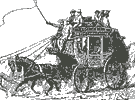 Butterfield
Mail establishes relay stations at F orts Belknap, Phantom Hill, Chadbourne,
on route through north and west Texas to El Paso.
Butterfield
Mail establishes relay stations at F orts Belknap, Phantom Hill, Chadbourne,
on route through north and west Texas to El Paso.
Fort Quitman is established near San Antonio-El Paso road.
Texas Rangers under "Rip" Ford, with Indian allies from Brazos agency, attack Comanche camp in Antelope Hills, Indian Territory.
U.S. Army Major Earl Van Dorn leads 2nd Cavalry, with Indian allies under 20-year-old Lawrence Sullivan "Sul" Ross, in attack on Comanches near Wichita Mountains, Indian Territory.
1859
White settlers' attacks and encroachments on Brazos reservations result in Indians' removal to reservations in Indian Territory.
Fort Stockton is established at Comanche Springs near intersection of San Antonio-El Paso road and Comanche raiding trail to Mexico.
Van Dorn leads expedition of 2nd Cavalry and Indian allies against Comanche camp at Crooked Creek, north of the Cimarron River in present Kansas.
1860
Texans votes with other southern states for John C. Breckenridge for U.S. president in election won by Abraham Lincoln.
 Lt.
Col. Robert E. Lee and four companies of 2nd Cavalry are deployed to Brownsville
to end cross-border raids by Texans and Mexicans.
Lt.
Col. Robert E. Lee and four companies of 2nd Cavalry are deployed to Brownsville
to end cross-border raids by Texans and Mexicans.
Texas Rangers and state volunteers under "Sul"
Ross, along with a detachment of 2nd Cavalry, attack a Comanche camp on
the Pease River; Cynthia Ann Parker, kidnapped in 1836 and now the mother
of the future Comanche warrior Quanah Parker, is recovered.
1861
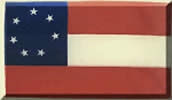 Statewide referendum determines that Texas should secede from the United
States; several Texas frontier counties vote to remain in the Union.
Statewide referendum determines that Texas should secede from the United
States; several Texas frontier counties vote to remain in the Union.
Butterfield Mail moves its operations out of Texas.
Bvt. Maj. Gen. David Twiggs, a southern loyalist who commands the U.S. Army's Department of Texas, surrenders U.S. forces to Texas state troops at San Antonio.
Texas secession convention creates three frontier
defense districts: a "northern" district from the Red River
to Fort Chadbourne a "middle" district from Fort Chadbourne
to the Rio Grande above Fort McIntosh; and a "southern" district
from Fort McIntosh to Fort Brown.
1862
 Confederate
President Jefferson Davis vetoes a bill authorizing a Confederate "Frontier
Regiment" to be to be established and used exclusively for frontier
defense in Texas. Texas spends $800,000 to support the Frontier Regiment
for the first 10 months of its existence. The state will continue to bear
all the expense of frontier defense for the next two years.
Confederate
President Jefferson Davis vetoes a bill authorizing a Confederate "Frontier
Regiment" to be to be established and used exclusively for frontier
defense in Texas. Texas spends $800,000 to support the Frontier Regiment
for the first 10 months of its existence. The state will continue to bear
all the expense of frontier defense for the next two years.
A "Union League," or "Peace Party" conspiracy is discovered in the northern frontier areas that voted against secession. Some 40 men are hanged by mobs in Cooke and Wise counties.
1863
Texas Legislature votes to turn the Frontier Regiment over to Confederate authorities. In its place is established a "Frontier Organization" consisting of a northern ("First") Frontier District lying generally north of the Brazos River, central ("Second") Frontier District generally between the Brazos and Colorado rivers, and southern ("Third") Frontier District generally between the Colorado River and Rio Grande.
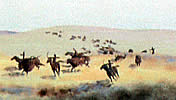 Indian
raids increase, with attacks in Cooke, Denton, Montague, Parker, and Wise
counties. Large-scale cattle raids become common.
Indian
raids increase, with attacks in Cooke, Denton, Montague, Parker, and Wise
counties. Large-scale cattle raids become common.
In December, some 300 Comanches attack settlements in Montague and Cooke counties and escape after driving off soldiers of the Frontier Regiment. Losses of white settlers and soldiers are estimated as 12-15 killed, seven wounded, and two-to-seven women and children carried away.
1864
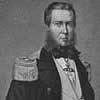 French
military forces install Archduke Maximilian as emperor of Mexico.
French
military forces install Archduke Maximilian as emperor of Mexico.
United States military operations in Louisiana and Gulf of Mexico divert attention of Texas Confederate forces from northern and western frontier defense.
Approximately 4,000 residents of frontier counties are enlisted in the Frontier Organization, including Tonkawa Chief Castile and 44 other Tonkawa warriors.
U.S. Army Col. Kit Carson leads California and New Mexico
volunteer cavalry against Comanche and Kiowa camps near the abandoned
"Adobe Walls" trading post in the Texas Panhandle. After a battle
of several hours, Carson and his command of about 350 narrowly escape
the 1,000 Indian warriors.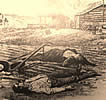
A force of 500 to 700 Comanche and Kiowa raiders under Little Buffalo raid settlements in Young County. The "Elm Creek" raid is the largest in Texas since 1840, with five white soldiers and seven settlers killed, seven women and children carried off, some 20 Indians killed, and numerous homes destroyed.
1865
In January, state and Confederate troops attack a camp of about 600 probably friendly Kickapoos emigrating from Indian Territory to Mexico. The "Battle of Dove Creek" near present San Angelo results in Texas and Confederate forces losing 26 killed and 23 wounded. Upon arriving in Mexico, the Kickapoo report 11 of their own killed and seven wounded.
In May, General Edmund Kirby Smith surrenders the Trans-Mississippi Department of the Confederacy to United States forces. More than 30,000 U.S. army troops begin to re-occupy forts along the Rio Grande to guard the border against French activity and establish posts in the interior of Texas to enforce new laws protecting freed slaves.
